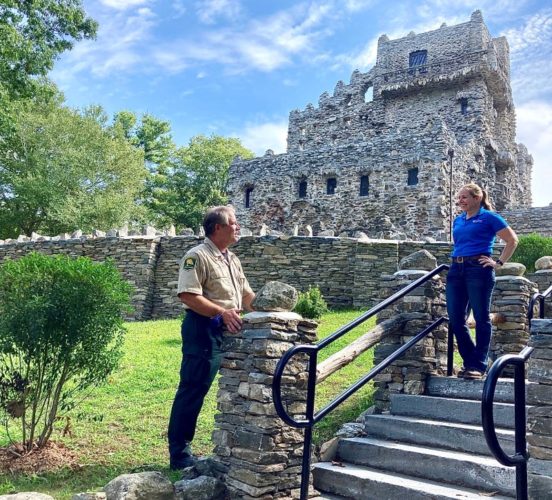
LYME/EAST HADDAM — If you’re as observant as Sherlock Holmes, consider this challenge: try to spot the latest exciting improvement at Gillette Castle.
Even though the change is huge, it’s so well disguised that you might not realize it’s there.
For a clue, look up the slope at the Castle’s entrance. You’ll see a set of stone stairs and a retaining wall buttressing the terraces. Both appear to be as rustic as William Gillette’s eccentric, century-old home, nestled atop the “Seventh Sister” hill in Gillette Castle State Park.
But it’s all an elaborate illusion, in keeping with Gillette’s famous reputation for theatrical flair while portraying the fictional detective on stage. Those structures actually are new, disguising a modern, steel-reinforced concrete retaining wall nearly 200 feet long and incorporating updated conveniences and building materials.
“It almost looks like we didn’t do anything,” mused Rodney Young, vice president of Baltic, Connecticut-based Mattern Construction Inc., which completed the project earlier this year at the park, which straddles the towns of East Haddam and Lyme along the Connecticut River.
In fact, Young hopes visitors familiar with the old wall and staircase don’t notice any difference between the updated features and their appearance from past years.
Decades of weathering and frost had rendered the original, dry-built retaining wall fragile and in need of persistent repairs. Replacement became a priority after a section collapsed a few years ago.
To prevent further deterioration and to bring the staircase into compliance with the Americans with Disabilities Act by including modern handrails, the Connecticut Department of Energy and Environmental Protection (DEEP) directed approximately $750,000 toward the project. It’s all part of a multi-phase funding package approved by the State Bonding Commission for improvements at the site.
Mattern Construction was awarded the first-phase project last year. As work got under way that September, Young and his crews knew they wouldn’t be allowed to change the structures’ historical appearance.
That called for careful coordination among Young; Mattern Construction project manager Heather Welsh; DEEP civil engineer Bill Coleman; Phil Yuris and Jack Hine of Old Lyme, respectively the former and current park supervisors; Scott Dawley, supervisor of the state parks system’s eastern district; and State Historic Preservation Office representatives.
Stones that Gillette’s own construction crews had set in place in the early 20th century were removed, labeled and meticulously preserved, Young said. Then a significant challenge loomed when it was found that a subsurface ledge required demolition – but without explosives.
“We didn’t want to do any blasting because of the damage it could have done to the castle,” Young said, noting that the home stands relatively nearby. The solution was to have Young’s crews drill a multitude of deep holes into the ledge, then inject them with a chemical that expanded, cracking the old foundation into small pieces that could be removed easily.
A new, reinforced concrete wall then was installed on the same location and covered with a veneer of stones from the original wall. All of the original rocks and flagstones were re-used, Young said.
“The biggest challenge we met was the ledge,” said Welsh, who managed the project for Mattern Construction. “Everything else went very well.”
Young said he has handled many such projects over nearly three decades of supervising reconstruction efforts, but said the Gillette Castle work was particularly demanding because of the historical features that demanded preservation.
“The rocks you see are the same that were laid 100 years ago,” Young said, adding that the new wall is resistant to the weather conditions that had attacked the old wall. “It was very satisfying, knowing that we put together something that [originally] was put together 100 years ago.”
“We’ve had numerous compliments from the public about how this was done,” said Hine, the park supervisor.
Visitors aren’t likely to notice some other aspects, Hine noted – such as an updated method by which the stairway is drained of rainwater. Here’s a hint: The filling between the flagstones is a substance called polymeric sand, not mortar, and helps prevent frost heaving and ice from forming.
The work’s completion earlier this year ended the first phase of the state’s three-phase capital-improvement effort at the park. Upcoming improvements include stonework repair at the sheltered vehicle entrance and resurfacing of the terrace. The work, including the retaining wall and staircase, is being funded through a $1.993 million allocation by the bonding commission.
Hine said the use of polymeric sand on the staircase serves as a trial method for what’s being specified to resurface the terrace during the overall project’s eventual third phase.
“The reconstruction of the wall is a major improvement to the park,” said Paul Schiller, vice president of The Friends of Gillette Castle State Park, a nonprofit, all-volunteer group dedicated to the preservation, conservation and educational activities of the castle and its grounds.
“Given the grand scale of the work, we are at ease knowing that the DEEP and the State of Connecticut support the castle and are willing to allocate significant resources to preserving it,” said Schiller, who also serves the park seasonally as supervisor of public education.
“I am thrilled to see the positive change that comes with the wall reconstruction,” Schiller said. “After years of patchwork, it is now rebuilt to stand for the long term. Likewise, the aesthetic value cannot be understated. Looking at photos of the finished wall, it looks so crisp and clean, you can tell that it is not an addition but an extension of the castle structure.”
“The biggest compliment we could get is that it looks like we were never here,” Welsh said. “That’s what we hoped for.”
An online video focusing on the project may be viewed at youtu.be/M5VczCYctC8 as well as the “photo/video gallery” page at www.gillettecastlefriends.org. The video was made possible by the Connecticut Department of Energy and Environmental Protection in partnership with The Friends of Gillette Castle State Park.
This article was taken from a press release issued by the Friends of Gillette Castle.